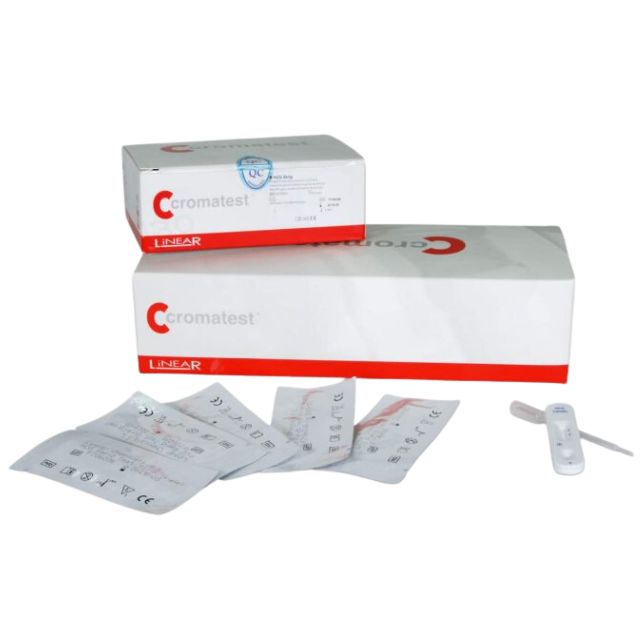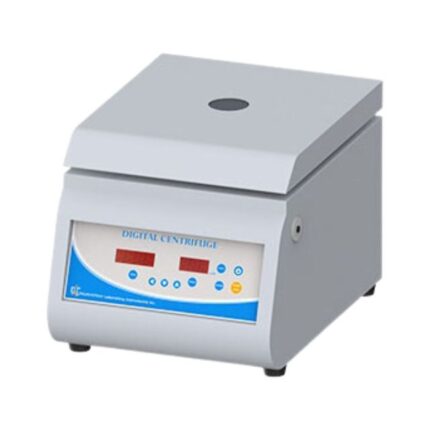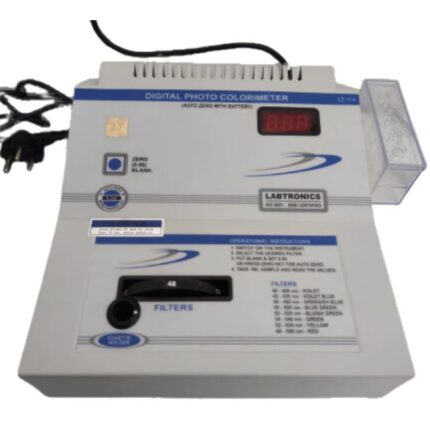CROMATEST Pregnancy (hcg) Test Strip
PRINCIPLE
The LINEAR B-hCG strip is a rapid chromatographic immunoassay for the qualitative detection of human chorionic gonadotropin in urine to aid in the early detection of pregnancy. The test utilizes a combination of antibodies including a monoclonal hCG antibody to selectively detect elevated levels of hCG.
The assay is conducted by immersing the test strip in a urine specimen and observing the formation of colored lines. The specimen migrates via capillary action along the membrane to react with the colored conjugate.
Positive specimens react with the specific antibody-hCG-colored conjugate and form a colored line at the test line region of the membrane. Absence of this colored line suggests a negative result.
To serve as a procedural control, a colored line will always appear in the control line region indicating that proper volume of specimen has been added and membrane wicking has occurred.
REAGENT COMPOSITION
LINEAR B-hCG strip contains anti-hCG particles and anti-hCG coated on the membrane.
PACKAGING CONTENTS
4120050 50 Pregnancy test strips.
STORAGE AND STABILITY
Store at 2-30ºC.
The test strip is stable through the expiration date printed on the sealed pouch. The test strip must remain in the sealed pouch until use. DO NOT FREEZE. Do not use beyond the expiration date.
SPECIMEN COLLECTION AND PREPARATION
A urine specimen must be collected in a clean and dry container.
A first morning urine specimen is preferred since it generally contains the highest concentration of hCG; however, urine specimens collected at any time of the day may be used.
Urine specimens exhibiting visible precipitates should be centrifuged, filtered, or allowed to settle to obtain a clear specimen for testing.
Urine specimen may be stored at 2-8°C for up to 48 hours prior to testing. For prolonged storage, specimens may be frozen and stored below -20°C. Frozen specimens should be thawed and mixed before testing.
MATERIALS REQUIRED
PROCEDURE
Allow the test strip, urine specimen and/or controls to equilibrate to room temperature (15-30°C) prior to testing.
CLINICAL SIGNIFICANCE
Human chorionic gonadotropin is a glycoprotein hormone produced by the developing placenta shortly after fertilization. In normal pregnancy, hCG can be detected in both urine and serum as early as 7 to 10 days after conception.1,2,3,4 hCG levels continue to rise very rapidly, frequently exceeding 100 mIU/mL by the first missed menstrual period,2,3,4 and peaking in the 100,000-200,000 mIU/mL range about 10-12 weeks into pregnancy. The appearance of hCG in both urine and serum soon after conception, and its subsequent rapid rise in concentration during early gestational growth, make it an excellent marker for the early detection of pregnancy.
The LINEAR B-hCG strip is a rapid test that qualitatively detects the presence of hCG in urine specimens at the sensitivity of 20 mIU/mL. The test utilizes a combination of monoclonal and polyclonal antibodies to selectively detect elevated levels of hCG in urine. At the level of claimed sensitivity, the LINEAR hCG Strip shows no cross-reactivity interference from the structurally related glycoprotein hormones hFSH, hLH and hTSH at high physiological levels.
ANALYTICAL PERFORMANCE
Table: hCG Rapid Test vs. EIA
Relative Sensitivity:
>99.8% (98.7%-99.9%)*
Relative Specificity:
>99.9% (99.8%-100.0%)*
hCG Rapid Test
+ – Total
Overall Agreement:
>99.9% (99.7%-99.9%)*
*95% Confidence Interval
Specificity
+
EIA
–
411
2292
411
2292
2703
The specificity of the hCG Rapid Test (Urine) was determined in cross reactivity studies with known amounts of Luteinizing Hormone (hLH), Follicle Stimulating Hormone (hFSH) and Thyroid Stimulating Hormone (hTSH). 300 mIU/mL hLH, 1000 mIU/mL hFSH and 1000 µIU/mL hTSH all produced negative results.
Interference testing
The following substances were added to hCG free urine and urine samples spiked with 20mIU/mL hCG.
None of the substances interfered with the assay at the listed concentrations.
Acetaminophen 20 mg/dL Acetylsalicylic Acid 20 mg/dL Ascorbic Acid 20 mg/dL
Atropine 20 mg/dL
Caffeine 20 mg/dL
Gentisic Acid 20 mg/dL
Glucose 2 g/dL
Hemoglobin 1 mg/dL
NOTES
- Very dilute urine specimens, as indicated by a low specific gravity, may not contain representative levels of If pregnancy is still suspected, a first morning urine specimen should be collected 48-72 hours later and tested.
- False negative results may occur when the levels of hCG are below the sensitivity level of the test. When pregnancy is still suspected, a first morning urine specimen should be collected 48-72 hours later and
- Very low levels of hCG (less than 50 mIU/mL) are present in urine specimen shortly after implantation. However, because a significant number of first trimester pregnancies terminate for natural reasons, weakly positive should be interpreted in conjunction with other clinical and laboratory
- A number of conditions other than pregnancy, including trophoblastic disease and certain non-trophoblastic neoplasms including testicular tumors, prostate cancer, breast cancer, and lung cancer, cause elevated levels of hCG.6,7 Therefore, the presence of hCG in urine specimen should not be used to diagnose pregnancy unless these conditions have been ruled
- Remove the test from its sealed pouch and use it as soon as For best results, the assay should be performed within one hour.
- Hold the strip by the end, where the product name is printed. To avoid contamination, do not touch the strip
- Holding the strip vertically, dip the test strip in the urine specimen for at least 10-15 seconds. Do not immerse past the maximum line (MAX) on the test
- As the test begins to work, color will migrate across the
- After the test has finished running, remove the strip from the specimen and place it on a non-absorbent flat surface. Start the timer and wait for the colored band(s) to appear. The result should be read at 3 minutes. Do not interpret the result after 10 minutes.
NOTE: Low hCG concentrations may produce very weak test bands (T) after a prolonged period of time. Therefore, do not interpret the result after 10 minutes.
RESULTS
POSITIVE: Pregnancy. Two distinct red lines appear. One line should be in the control region (C) and another line should be in the test region (T). NOTE: The intensity of the red color in the test line region (T) will vary depending on the concentration of hCG present in the specimen. Therefore, any shade of red in the test region (T) should be considered positive.
NEGATIVE: Non pregnancy. One red line appears in the control region (C). No apparent red or pink line appears in the test region.
INVALID: Control line fails to appear. Insufficient specimen volume or incorrect procedural techniques are the most likely reasons for control line failure. Review the procedure and repeat the test with a new test strip. If the problem persists, discontinue using the test kit immediately and contact your local distributor.
QUALITY CONTROL
A procedural control is included in the test. A red line appearing in the control region (C) is the internal procedural control. It confirms sufficient specimen volume and correct procedural technique.
It is recommended that a positive hCG control (containing 20-250 mIU/mL hCG) and a negative hCG control (containing “0” mIU/mL hCG) be evaluated to verify proper test performance when a new shipment of test devices are received.
PRECAUTIONS
- Do not use the test if the foil pouch is damaged. Do not reuse
- This kit contains products of animal Certified knowledge of the origin and/or sanitary state of the animals does not completely guarantee the absence of transmissible pathogenic agents. It is therefore recommended that these products be treated as potentially infectious, and handled observing usual safety precautions (e.g., do not ingest or inhale).
- Avoid cross-contamination of specimens by using a new specimen collection container for each specimen
- Read the entire procedure carefully prior to
- Do not eat, drink or smoke in the area where the specimens and kits are Handle all specimens as if they contain infectious agents. Observe established precautions against microbiological hazards throughout the procedure and follow standard procedures for the proper disposal of specimens. Wear protective clothing such as laboratory coats, disposable gloves and eye protection when specimens are assayed.
- Humidity and temperature can adversely affect results.
- Used testing materials should be discarded according to localregulations.
REFERENCES
- Braunstein GD, Vaitukaitis JL, Carbone PP, Ross GT. Ectopic production of human chorionic gonadotrophin by neoplasms. Ann Intern Med. 1973 Jan; 78(1): 39-45.
- Catt KJ, Dufau ML, Vaitukaitis JL. Appearance of hCG in pregnancy plasma following the initiation of implantation of the J Clin Endocrinol Metab. 1975 Mar; 40(3): 537-40.
- Braunstein GD, Rasor J, Danzer H, Adler D, Wade Serum human chorionic gonadotropin levels throughout normal pregnancy. Am J Obstet Gynecol. 1976 Nov 15; 126(6): 678-81.
- Rasor JL, Braunstein GD. A rapid modification of the beta- hCG radioimmunoassay. Use as an aid in the diagnosis of ectopic Obstet Gynecol. 1977 Nov; 50(5): 553-8.
- Engvall E. Enzyme immunoassay ELISA and EMIT. Methods 1980; 70(A): 419-39.
- Batzer Fertil Steril. Hormonal evaluation of early pregnancy. 1980 Jul; 34(1): 1-13.
- Lenton EA, Neal LM, Sulaiman R. Plasma concentrations of human chorionic gonadotropin from the time of implantation until the second week of pregnancy. Fertil Steril. 1982 Jun; 37(6): 773-8.
- Thompson RJ, Jackson AP, Langlois N. Circulating antibodies to mouse monoclonal immunoglobulins in normal subjects– incidence, species specificity, and effects on a two-site assay for creatine kinase-MB Clin Chem. 1986 Mar; 32(3): 476-81.











Reviews
There are no reviews yet.